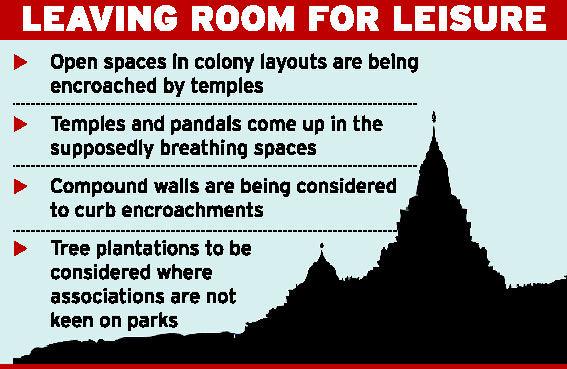The GHMC finds itself helpless as any attempt to remove a religious structure hurts ‘public sentiments’
While the political tussle between green and saffron is all too well known, here is another kind between the two, in a totally different milieu. Open spaces allocated for parks in burgeoning colonies across Greater Hyderabad, are becoming the favoured spots for construction of temples.
While at times it is a decision approved by colony welfare associations, most often, the spaces are grabbed by vested interests. The GHMC, to whom the open spaces technically belong, is helpless once the temple is in place, as any attempt to remove the structure hurts ‘public sentiments’.
Officials from the GHMC say that the problem is rampant in colonies which have come up in the last 10 to 15 years. Monitoring all open spaces in the ever-expanding city is a herculean task without community surveillance.
According to the rulebook, 20 per cent of the space in any layout within the GHMC should be marked for open spaces. Of this, about 10 per cent goes for laying of roads, with the remaining usually allocated for parks. Earlier, such open spaces would be used up for community halls or schools or even play grounds. However, of late, temples and permanent pandals for festivals have come up in the allocated areas, that too without objection from local residents.
“There was this vegetable seller who occupied the park space in Kamalapuri Colony and refused to move. When Town Planning officials served him notices, he obtained a stay from court. Within a short time, a temple came up in the area, making it impossible for us to go any further,” said an official.
The authorities could successfully thwart an attempt to construct a temple at Habsiguda, while at Mayurnagar in Serilingampally it was a fait accompli before they could react. A sprawling temple complex came up where a park was planned. Similar was the case at Green Park Colony in LB Nagar limits.
“At one more place, the colony welfare association approached us for a park. But the space already had a pandal in it which the association wanted to retain. We asked them to choose between the pandal and the park,” the officer said.
In Kundanbagh too, officials have been thwarting attempts to construct a temple for the last one year. Once, they had to bulldoze the structure. At a few places where temples have already come up, the attempt is to fence them off, and develop parks in the remaining space. Also, compound walls are being mulled over as a solution to protect vacant spaces. However, it is a cost-intensive proposition as each wall costs Rs.20 lakh to Rs.30 lakh, the official added.
“If the colony welfare associations are not keen on having a park, we are planning to plant trees and lay pathways,” he said.




Leave a reply